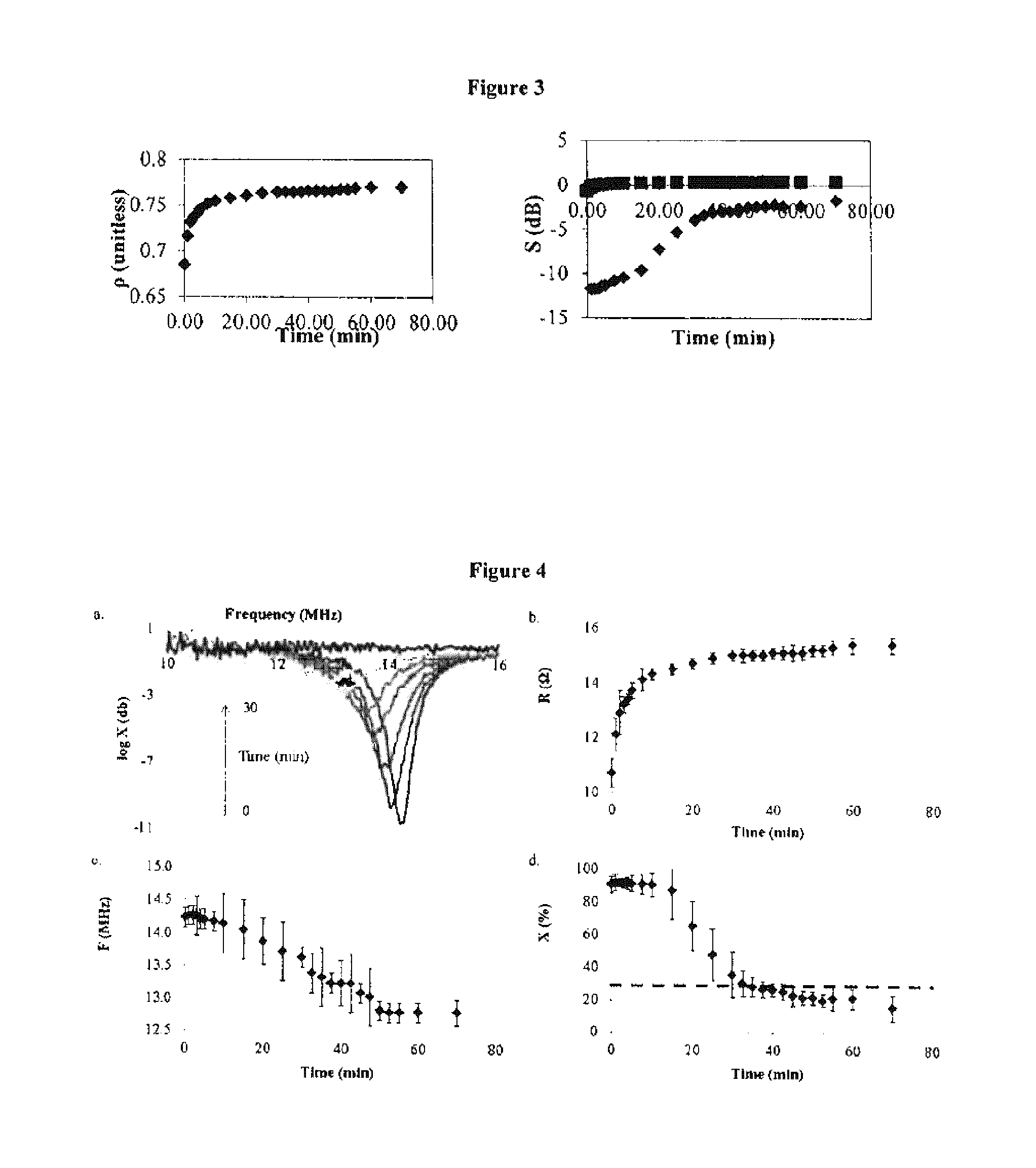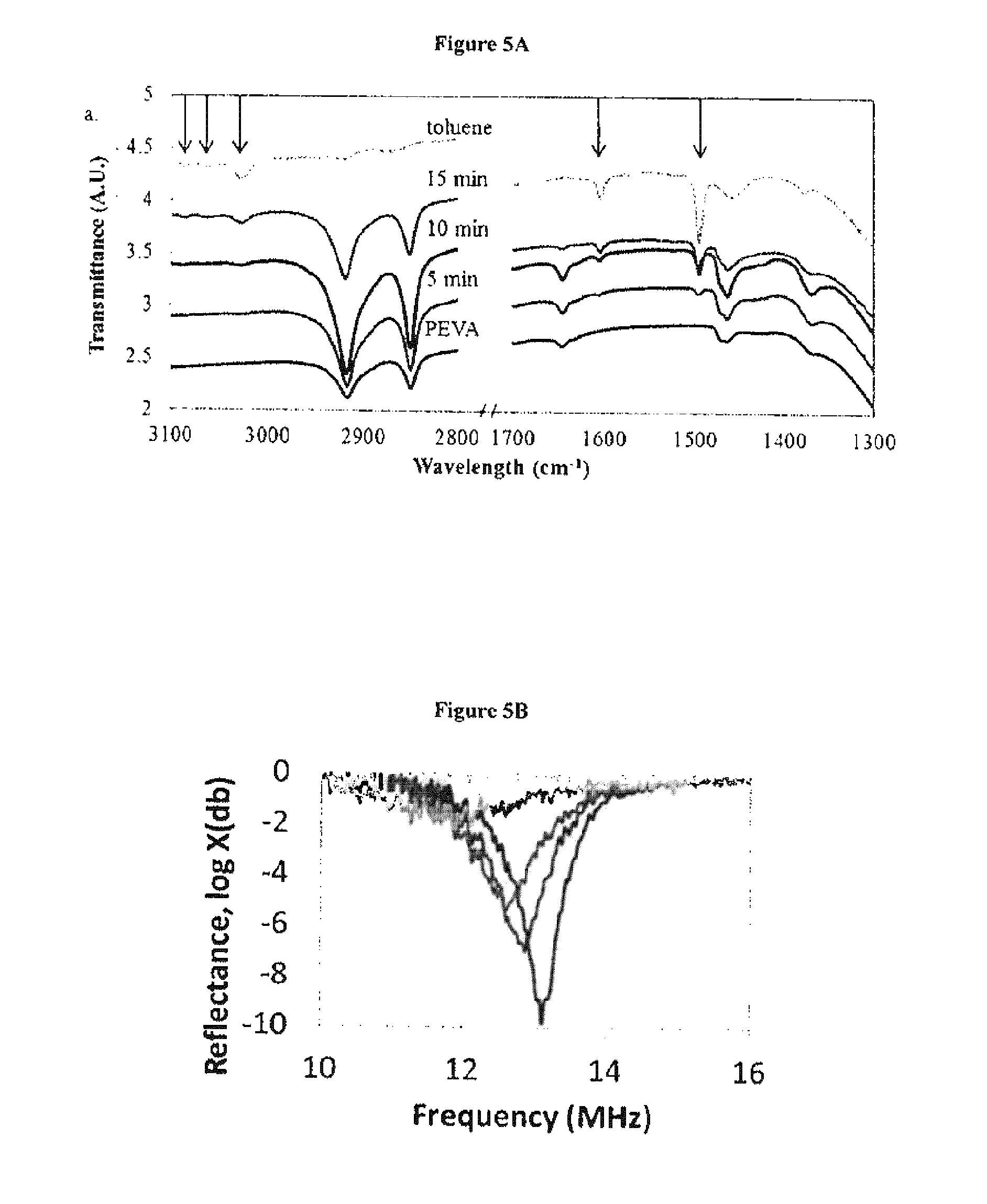Radio frequency identification (RFID) devices for detecting volatile substances
- Summary
- Abstract
- Description
- Claims
- Application Information
AI Technical Summary
Benefits of technology
Problems solved by technology
Method used
Image
Examples
example 1
[0090]The conducting composite was integrated onto the RFID device between the device's integrated circuit and antenna. A solution of 18 weight % carbon and 82 weight % polymer (see Table 1) was prepared for a total of 0.1 g in 15 mL of water, chloroform, or THF depending on the solubility of the polymer. The solution was sonicated for 3 h at room temperature. The unmodified RFID devices were received as a copper antenna sandwiched between two plastic sheets. The top plastic sheet was removed and the copper antenna was cleaned with acetone to remove any adhesive. The silver conductive paste that runs between the tag's integrated circuit and the antenna was modified with the conductive composite. First, the area was masked off by applying the silicone elastomer to the area identified above and curing for 2 h at 70° C. Once cured, the silicone was cut so that only the area with the conductive paste was exposed, and the remaining area was masked off with the silicone elastomer. Second,...
example 2
[0091]A solution of 18 weight % carbon black, 50 weight % PEVA and 32 weight % maleic acid was prepared for a total of 0.15 g in 15 mL of chlorobenzene. The solution was heated for 1 h in a 70° C. oven then sonicated for 1 h at room temperature. The unmodified RFID devices were received as a copper antenna sandwiched between two plastic sheets. The top plastic sheet was removed and the copper antenna was cleaned with acetone to remove any adhesive. The silver conductive paste that runs between the tag's integrated circuit and the antenna was modified with the conductive composite. First, the area was masked off by applying the silicone elastomer to the area identified above and curing for 2 hours at 70° C. Once cured the silicone was cut so that only the area with the conductive paste was exposed and the remaining area was masked off with the silicone elastomer. Second, 10 μL of the conductive composite solution was pipetted onto the masked area and heated to 80° C. for 10 minutes t...
example 3
[0092]Conductive composite films were characterized on an attenuated total reflection (ATR) FTIR apparatus. Films of PEVA were cast on silicon wafers. The films were then attached to the inside lid of the environmental chamber and exposed to 377 ppm toluene for 15 minutes. ATR-FTIR measurements were conducted using a single reflection Ge ATR crystal accessory (PIKE Tech.) attached to a Vertex 70 FTIR spectrometer (Bruker Inc.) as described previously (J. Greenerm B. Abbasim E. Kumacheva, Lab on a chip 2010, 10, 1561). Spectra were obtained for the films before exposure, after 5, 10, and 15 min of exposure to toluene and for liquid toluene. FIG. 5A shows the FTIR spectra obtained. Peaks at 3094, 3071, and 3034 cm−1 are C—H stretching for aromatic toluene. Peaks at 1607, and 1503 cm−1 are C—C stretching for aromatic toluene. These aforementioned peaks are not in the PEVA spectrum but are shown to appear as the film is exposed to toluene confirming the analyte adsorption to the film.
PUM
 Login to View More
Login to View More Abstract
Description
Claims
Application Information
 Login to View More
Login to View More - R&D
- Intellectual Property
- Life Sciences
- Materials
- Tech Scout
- Unparalleled Data Quality
- Higher Quality Content
- 60% Fewer Hallucinations
Browse by: Latest US Patents, China's latest patents, Technical Efficacy Thesaurus, Application Domain, Technology Topic, Popular Technical Reports.
© 2025 PatSnap. All rights reserved.Legal|Privacy policy|Modern Slavery Act Transparency Statement|Sitemap|About US| Contact US: help@patsnap.com



